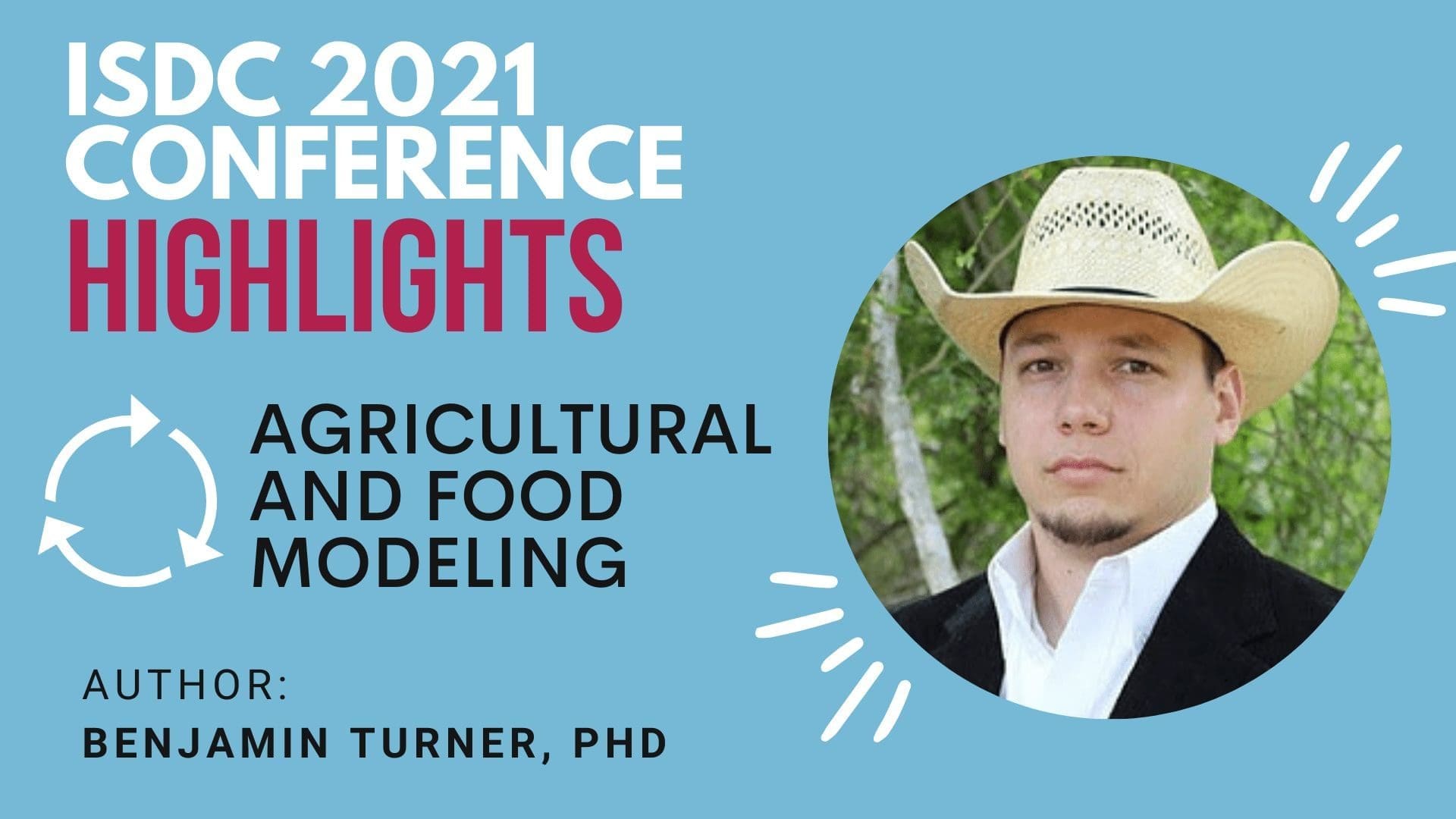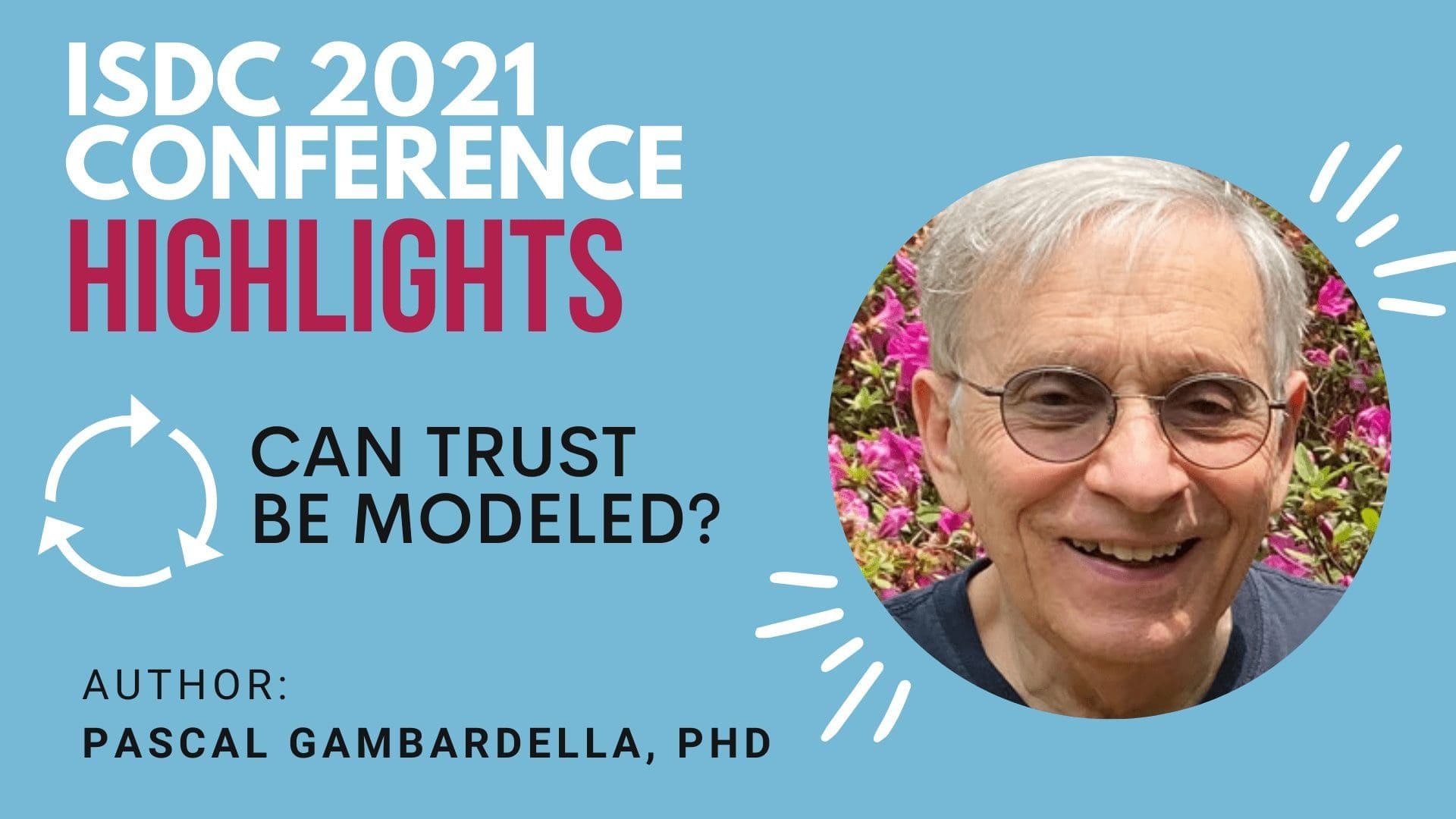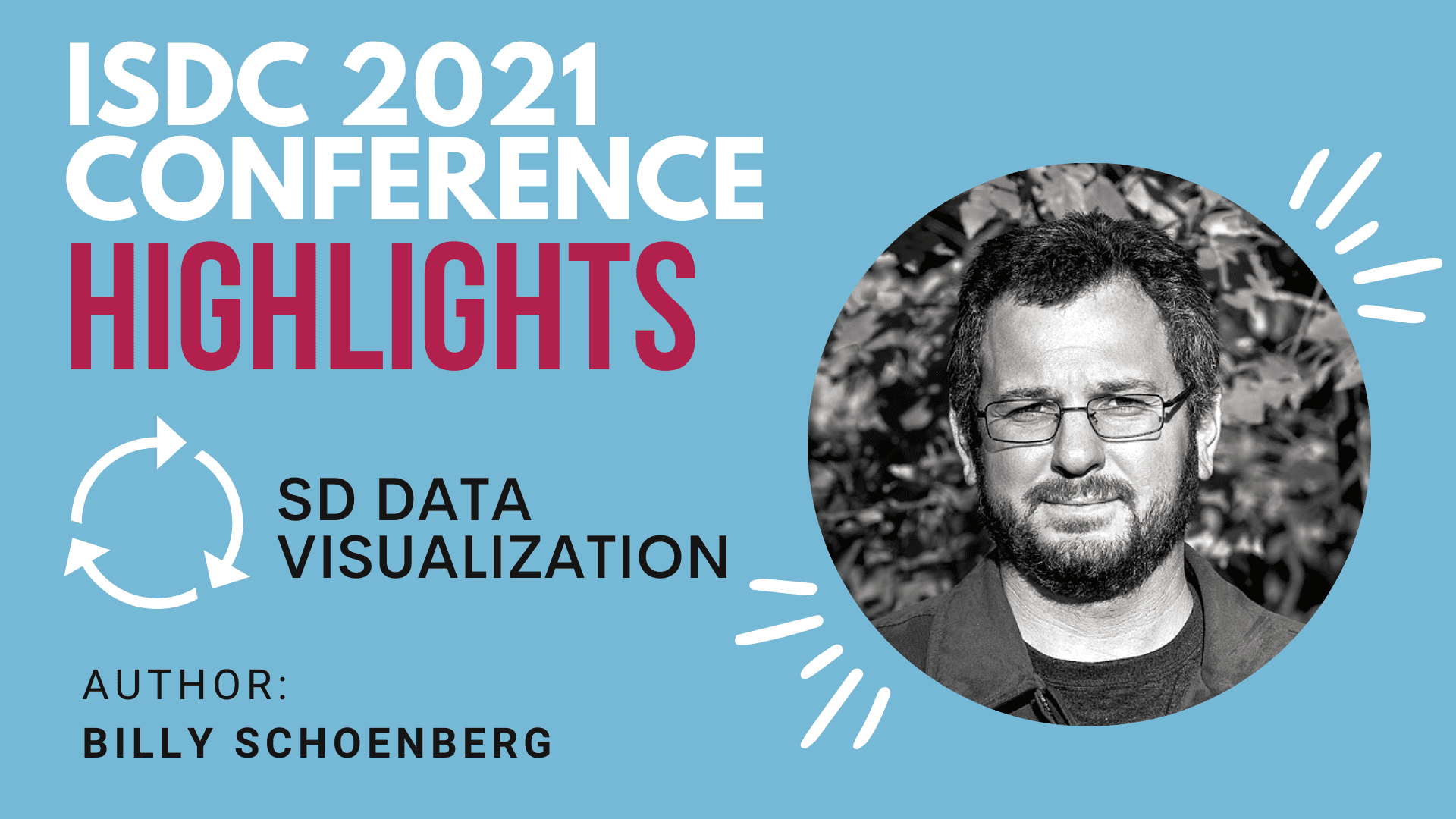ISDC 2021 Highlights: Agricultural and food modelers produce a crop of conference contributions
The International System Dynamics Conference (ISDC) convenes practitioners who demonstrate what’s new and developing in their fields with System Dynamics. This section of the WiSDom Blog, “Conference Highlights,” asks system dynamicists to spotlight key presentations and innovations presented at the conference.
– Conference Highlights Editorial Team: Saras Chung, Will Glass-Husain, Jack Homer, Sara Metcalf, and Remco Peters with coordination by Christine Tang
This highlight by Dr. Benjamin Turner spotlights Agriculture and Food modeling work that was presented at the conference. Special thanks to Dr. Remco Peters for his editorial support on this post.
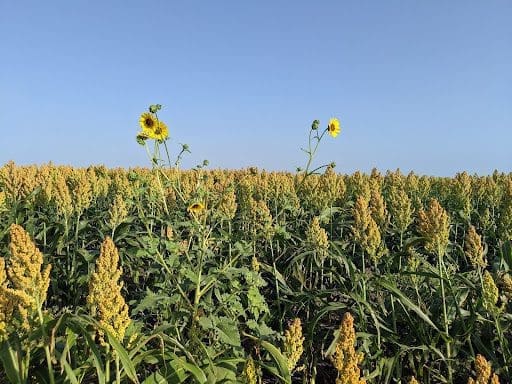
Agricultural and food modelers produce a crop of conference contributions
A society’s ability to produce and distribute food is essential for its survival and unleashing human potential. Given the 21st century challenges of population growth and conserving natural resources, it is crucial to improve the performance of local, national, and global agri-food systems. Many system dynamicists are actively working to address such issues. The 2021 International System Dynamics Conference showcased much of this important work.
For instance, in the global south, food inequity among small-holder farmers is a challenge that was examined by several system dynamicists. Sandra Volken explained that many families in Senegal (West Africa) had to abandon their lands due to declining groundwater tables and the growth of corporate vegetable growers. James Enos presented another example of food inequity in the Upper Nile Basin (Ethiopia and Uganda), where agricultural lands dependent on rainfall put tremendous pressure on small-holder farmers to convert their land for other uses. James illustrated how weather patterns strengthen the oscillatory nature of crop dynamics, leading to a fewer number of crops being grown over larger areas. In the poultry sector, Kelechi Odoemena and his team presented an innovative intervention to address food inequity challenges, which employs a flight-simulator to teach small-scale producers production and financial management principles using key performance indicators (KPIs).
In the global north, important industry-wide challenges are being tackled using System Dynamics. Talks by April Roggio and Alberto Atzori focused on realignment issues causing inequities in the dairy industry. Roggio updated a DYNAMO model originally built in 1976 and demonstrated how competition in a limited market slows down farm ownership transitions, restricts new and young farmers from entering the industry, and accelerates land price appreciation through fragmentation. Atzori and collaborators worked together with the largest milk producers in Italy to develop a general herd management model, calibrated to the best available industry data. Their model is already being used by farm managers to plan milk market deliveries and reduce fluctuating milk and cow inventories.
Some agri-food issues are more ecologically-driven, such as weed herbicide resistance. One of my students, Chris Flores-Lopez, presented a model to address this issue and its impact on long-term cropping system feasibility. His model demonstrated that accumulations of resistant weed seeds in the soil seed bank are only manageable in the short-term (3-5 years) with “status quo” practices of chemical switching. Subsequent tests showed a more hopeful picture. Integrated solutions taking advantage of weed-crop interference pressures can reduce crop losses despite weed seedbank accumulation.
“Farm to fork” challenges at a consumer level were also shared at the conference. Simone Peters and Inge Bleijenbergh’s causal loop diagram of Dutch household food dynamics highlighted the gap of consumer awareness necessary to motivate significant conservation efforts. April Roggio’s team identified ways to model and manage foodshed resiliency. Their work is laying a foundation that warrants much more attention from scientists in our field.
A critical insight emerged from these contributions. Purely technical solutions such as water well installation, switching chemical herbicides, or maximizing milk yield are no longer effective. Instead, future solutions require social or organizational interventions that drive individual decision patterns responsible for reinforcing undesirable or unintended outcomes. This includes revising incentive structures surrounding water resources and livestock markets or implementing more complex cropping systems to build resiliency.
Global Collaboration through the SDS Agriculture and Food Special Interest Group (SIG)
Many of the presenters highlighted above have been actively engaged in the SDS’s Agriculture and Food Special Interest Group (A&F SIG). The success of the SDS’s investment in SIGs may be best illustrated by a recent collaborative effort. Led by Busra Atamer Balkan, the A&F SIG team built a stock-and-flow model, which illustrated how barriers to input supplies and market access were disproportionately affecting smallholder producers during the COVID pandemic. Their resulting framework facilitates dialogue among stakeholders and provides critical modeling structures that I would recommend to anyone studying the impact of COVID on food supplies. This project began as an idea during a SIG meeting, was developed into a conference presentation, and is now peer-reviewed and forthcoming in the International Journal on Food System Dynamics.
The 2021 System Dynamics conference was a tremendous success for transdisciplinary problem-solving. It was remarkable to see parallel challenges in the field despite diverse socio-economic, cultural, or geographic contexts. Discussions during this conference have kick-started several post-conference collaborations and projects. Transdisciplinary approaches to address agri-food system challenges can be accelerated through engagement with System Dynamics Society members and participation in annual conferences or SIGs.
We should all be encouraged that system dynamicists around the world are taking on some of the most important agricultural and food-related issues. I know that I am.
Benjamin Turner
Dr. Benjamin Turner is an Associate Professor of Natural Resource Management at Texas A&M University-Kingsville and co-organizer of the Agricultural and Food Special Interest Group of the System Dynamics Society.
ISDC 2021 Highlights: Can Trust be Modeled?
ISDC 2021 Highlights: Can Trust be Modeled?
The International System Dynamics Conference (ISDC) convenes practitioners who demonstrate what’s new and developing in their fields with System Dynamics. This section of the WiSDom Blog, “Conference Highlights,” asks system dynamicists to spotlight key presentations and innovations presented at the conference.
– Conference Highlights Editorial Team: Saras Chung, Will Glass-Husain, Jack Homer, Sara Metcalf, and Remco Peters with coordination by Christine Tang
This highlight by Dr. Pascal Gambardella discusses the use of “trust” in modeling in presentations shared at ISDC.

Can Trust be Modeled?
What we trust, whom we trust, and how we build and maintain trust are central questions for all individuals and organizations. Several of the presentations at the 2021 International System Dynamics Conference (ISDC) grappled with modeling trust.
I had previously given some thought to this topic. At the 2020 ISDC, David Lounsbury and I (the two of us co-leaders of the System Dynamics Society’s Special Interest Group in Psychology) led a workshop on modeling soft constructs such as reputation. We introduced Daniel Diermeier’s “trust radar” factors (transparency, rapport, expertise, and commitment) and used two of them in a model of Diermeier’s “reputational crisis”.
I’m glad to see that other System Dynamics modelers are thinking about this topic as well. The 2021 ISDC presentations I attended addressed trust in the contexts of government, business, and personal relationships. I’ll address each of these.
Trust in Government:
Jorge Valencia and his team modeled the effect of trust in managing COVID-19 in Colombia. Jorge said the government’s blundering actions have caused people to lose trust in its ability to handle the crisis. His team’s approach relied on two models, one qualitative and one quantitative.
The qualitative model was an adaptation of Nobel Prize-winner Elinor Ostrom’s model of trust, in which trust, reputation, reciprocity, and cooperation form a reinforcing loop. Trust in government increases when it communicates the right information to the public. The problem is deciding which information is the most effective: realistic but offering hope. The COVID epidemic offers a perfect example of this dilemma. 
Valencia’s quantitative model uses a Susceptible-Infected-Recovered (SIR) structure with a trust variable. The effectiveness of government mandates is improved when people have some confidence in them and thus cooperate. The resulting reduction in infections and deaths would build even more trust.
Valencia said the Colombian government’s poor response to the pandemic led to protests and worsened the crisis. He asked the audience for help in creating a “trust index” to promote best government practices during a pandemic. I wondered if Diermeier’s “trust radar” might help here.
Trust in Business:
In a talk on structural racism, Peter Hovmand said “collaboration moves at the speed of trust.” This reminded me of Florian Kapmeier and Jeroen Struben’s presentation exploring trust dynamics during early business alliance activities.
Alliances allow businesses to share and combine resources, supporting innovation. However, knowledge exchanges can also cause trouble when one partner fails to fulfill certain obligations under the agreement. How can building trust early in the relationship mitigate this risk?
Kapmeier and Struben’s simulation model includes several major mechanisms and feedback loops. For example, greater management commitment to the alliance can improve partner contributions and interactions, building trust. Also, meeting expectations under the alliance can help to build trust. On the other hand, trust naturally tends to decay over time.
Among the various insights, a counterintuitive one stood out to me. The authors said: “Strategies seeking to build early trust rapidly or to maximize openness may backfire.” This can happen if the partners don’t achieve the high aspirations set during an initial honeymoon period.
Trust in Relationships:
At the Student-Organized Colloquium, Josephine Musango said: “Building trust is key to building relationships for resilience.” I recalled these words when I heard Sarah Pritchard and Lucy Puckett later present on “the terrible bargain” in human relationships. This term, perhaps coined by feminist blogger Melissa McEwan, refers to a situation in which a man’s sexism forces a woman to choose between her dignity and a peaceful relationship. As McEwan puts it, “If I can’t trust you to care when I tell you you’ve hurt me, how can I trust you at all?”
What are the mechanisms that lead to this disparity in trust between men and women who initially respect each other? Pritchard, Puckett, and their co-author Andrew Brown created a causal-loop diagram to explore this question.
In it, we see how a man may respond defensively to potentially helpful feedback from his female partner about his sexist behavior. This antagonistic response may cause her to lose trust and subsequently share less, thus damaging the relationship.
After their fascinating presentation, David Lounsbury and I interviewed Pritchard and Puckett about their work and asked whether this model might apply to other types of relationships and situations.
Sarah Pritchard said, “It’s possible that the model might also apply to other forms of oppression, but we’ve framed it around sexism for now. It’s rooted in situations where there’s an oppressive power imbalance and stereotype threat against giving critical feedback.”
Lucy Puckett added, “It could apply to any sort of relationship in which there is a level of emotional investment, something at stake, that contributes to the power imbalance. Women are in a difficult situation, having to sacrifice their own safety, trust, and authenticity for the sake of maintaining a relationship.”
—
Pascal Gambardella, PhD, started his career as a mathematical physicist and now does research using System Dynamics and Neuro-Semantics. He co-leads the Psychology and Human Behavior SIG of the System Dynamics Society.
Check out the Society’s SIGs – including the Psychology and Human Behavior SIG
Recent Posts
From Bergen to Global: UiB’s System Dynamics Group
From Bergen to Global: UiB’s System Dynamics Group The System Dynamics Group, an autonomous research group at the University of Bergen (UiB) was established in 1971 by professor emeritus Svein Nordbotten. Inspired by the work of Jay W. Forrester, Nordbotten...
Consideo’s Insight into the Global Energy Transition: A Systems Perspective
Consideo’s Insight into the Global Energy Transition: A Systems Perspective Complexities of Energy TransitionThe global energy transition is a complex challenge. The development of technology, the need for resources, the depletion of high-grade materials and...
A Digital Twin Business Model in 40 Hours
A Digital Twin Business Model in 40 Hours Though long past the date when I should have ‘retired’, I just can’t resist interesting projects, like the one a new friend brought me a few weeks ago. It concerns a small but fast-growing B2B business,...
Upcoming Events
MINDS Cast Ep. 5 – Expanding System Dynamics with Hybrid Modeling
This talk discusses extensions to System Dynamics modeling to integrate other modeling methods, notably Agent-Based Modeling. We will explore techniques for Agent-Based Modeling and how to integrate them into System Dynamics models; we will see how to extend...
Recent Business cases
Fast-Track Cities Uses System Dynamics to Enhance HIV Care
Fast-Track Cities Uses System Dynamics to Enhance HIV Care EXECUTIVE Summary Low levels of viral suppression at 69% for people with HIV make it hard to believe the 95% target level will be achieved by 2030 in St. Louis, USA. As a solution, Fast-Track Cities-STL opted...
System Dynamics Unravels ICU Tensions at the Portuguese Oncology Institute
System Dynamics Unravels ICU Tensions at the Portuguese Oncology Institute EXECUTIVE Summary The Portuguese Oncology Institute (IPO) faced a critical challenge in its intensive care unit (ICU) where doctors and nurses experienced high turnover due to tensions with...
System Dynamics Helps Farmers Escape Poverty Trap in Guatemala
System Dynamics Helps Farmers Escape Poverty Trap in Guatemala EXECUTIVE Summary Guatemala holds the 4th highest global ranking for chronic malnutrition, and climate change is intensifying the challenges subsistence farmers face in providing food for their families....
Join us
ISDC 2021 Highlights: Modeling for Action in Environmental Health
ISDC 2021 Highlights: Modeling for Action in Environmental Health
The International System Dynamics Conference (ISDC) convenes practitioners who demonstrate what’s new and developing in their fields with System Dynamics. This section of the WiSDom Blog, “Conference Highlights,” asks system dynamicists to spotlight key presentations and innovations presented at the conference.
– Conference Highlights Editorial Team: Saras Chung, Will Glass-Husain, Jack Homer, Sara Metcalf, and Remco Peters with coordination by Christine Tang
This highlight by Martha McAlister shares a first-time conference attendee’s perspective on modeling for action in environmental health.

Modeling for Action in Environmental Health
When environmental risks remain unmitigated, they end up hurting our ability to lead healthy and productive lives. These risks are often concentrated where populations are the most marginalized, thereby creating or contributing to unjust health disparities. Environmental health and justice problems can be complex, as they intersect multiple domains (social, economic, political, legal, institutional, etc.) and may involve years or decades of lag time, starting from the accumulation of multiple exposures and ending in life-threatening chronic illnesses.
System Dynamics offers opportunities for modelers to engage with broad audiences to address environmental health and justice challenges. Modelers can elicit public or expert participation before, during, and after the modeling process to promote confidence in the results and to encourage holistic learning that goes beyond narrowly epidemiological approaches.
As a first-time attendee of the International System Dynamics Conference, I wanted to learn how System Dynamics is being used in the environmental health context and about the challenges of applying System Dynamics to such complex problems.
The first hint came during the Student-Organized Colloquium, where keynote speaker Dr. Josephine Musango stated that “engagement is crucial.” As the conference progressed, I heard several presenters talk about their use of participatory modeling to study global environmental and health issues.
Laurent Smets spoke about using group model building with virology experts to connect early vaccine research and development to the user requirements at the “last mile” in low- and middle-income countries.
Kelsey Werner described workshops with local community groups in India (organized by the Social Systems Design Lab at Washington University) to model factors affecting their use of less harmful liquefied petroleum gas (e.g., for cooking) in place of solid fuels like firewood or charcoal..
Others reported on using System Dynamics simulation interfaces that engage stakeholders. As Juliette Rooney-Varga put it, this requires translating well-informed scientific models into meaningful, recognizable intervention levers and outputs.
Allyson Beall King, presenting on her work with Tyler Opp, echoed this concept of scientific translation in describing their model of toxic sediments in Lake Coeur d’Alene. They wanted to make sure this model would not only satisfy scientists but also be fully accessible and transparent for the public.
I also learned from Daniel Kliem’s talk about how to involve experts in participatory modeling. He said that if a simulation was the ultimate goal, then one should “fail fast” by developing the quantitative model sooner rather than later. He also advised modelers to remember that we are the translators and integrators of others’ knowledge, and as such we should always give those experts the credit they are due.
This last point reminded me of something that the other Student-Organized Colloquium keynote speaker, Dr. Irene Headen, said about one of the strengths of System Dynamics: the process allows modelers to collect and integrate multiple perspectives on a single topic.
The conference is a heady experience for a first-time attendee like myself. Thinking about the presentations I attended, I realize that none precisely addressed environmental health and justice per se. But that doesn’t really matter, because the presenters made it easy to see how their experiences and insights have broad application, and I look forward to applying these ideas in my own work.
Martha McAlister – mcalisterm@usf.edu
Martha is a PhD student of Environmental Engineering at the University of South Florida. She studies the efficacy and sustainability of environmental health interventions. Martha’s participation in the International System Dynamics Conference was supported by USF NRT Strong Coasts (National Science Foundation under Grant No. 1243510). Any opinions, findings, and conclusions or recommendations expressed in this material are those of the authors and do not necessarily reflect the views of the National Science Foundation, USF, or NRT Strong Coasts.
Check out the Society’s SIGs – including Environmental SIG and Health Policy SIG
Recent Posts
From Bergen to Global: UiB’s System Dynamics Group
From Bergen to Global: UiB’s System Dynamics Group The System Dynamics Group, an autonomous research group at the University of Bergen (UiB) was established in 1971 by professor emeritus Svein Nordbotten. Inspired by the work of Jay W. Forrester, Nordbotten...
Consideo’s Insight into the Global Energy Transition: A Systems Perspective
Consideo’s Insight into the Global Energy Transition: A Systems Perspective Complexities of Energy TransitionThe global energy transition is a complex challenge. The development of technology, the need for resources, the depletion of high-grade materials and...
A Digital Twin Business Model in 40 Hours
A Digital Twin Business Model in 40 Hours Though long past the date when I should have ‘retired’, I just can’t resist interesting projects, like the one a new friend brought me a few weeks ago. It concerns a small but fast-growing B2B business,...
Upcoming Events
MINDS Cast Ep. 5 – Expanding System Dynamics with Hybrid Modeling
This talk discusses extensions to System Dynamics modeling to integrate other modeling methods, notably Agent-Based Modeling. We will explore techniques for Agent-Based Modeling and how to integrate them into System Dynamics models; we will see how to extend...
Recent Business cases
Fast-Track Cities Uses System Dynamics to Enhance HIV Care
Fast-Track Cities Uses System Dynamics to Enhance HIV Care EXECUTIVE Summary Low levels of viral suppression at 69% for people with HIV make it hard to believe the 95% target level will be achieved by 2030 in St. Louis, USA. As a solution, Fast-Track Cities-STL opted...
System Dynamics Unravels ICU Tensions at the Portuguese Oncology Institute
System Dynamics Unravels ICU Tensions at the Portuguese Oncology Institute EXECUTIVE Summary The Portuguese Oncology Institute (IPO) faced a critical challenge in its intensive care unit (ICU) where doctors and nurses experienced high turnover due to tensions with...
System Dynamics Helps Farmers Escape Poverty Trap in Guatemala
System Dynamics Helps Farmers Escape Poverty Trap in Guatemala EXECUTIVE Summary Guatemala holds the 4th highest global ranking for chronic malnutrition, and climate change is intensifying the challenges subsistence farmers face in providing food for their families....
Join us
ISDC 2021 Highlights: A Peek into the Future of System Dynamics Visualization
ISDC 2021 Highlights: A Peek into the Future of System Dynamics Visualization
The International System Dynamics Conference (ISDC) convenes practitioners who demonstrate what’s new and developing in their fields with System Dynamics. This section of the WiSDom Blog, “Conference Highlights,” asks system dynamicists to spotlight key presentations and innovations presented at the conference. Check it out and let us know what you think!
– Conference Highlights Editorial Team: Saras Chung, Will Glass-Husain, Jack Homer, Sara Metcalf, and Remco Peters with coordination by Christine Tang
This highlight by Billy Schoenberg gives us a peek into the future of System Dynamics data visualization.
I’d like to describe a fascinating Plenary Session I attended on Tuesday of this year’s conference. Entitled “Visual HPC Workflows for the Analysis of System Dynamics Models” (HPC stands for High-Performance Computing), the 30-minute plenary talk was given by Brian Bush and Danny Inman of the US National Renewable Energy Laboratory (NREL).
Here’s the background. Over the past two decades, NREL has developed a series of large System Dynamics models, many of them open source. A big part of the task has been to exercise the models over wide ranges of uncertainty. This means, first, developing technology to run these models on NREL’s HPC supercomputer clusters. Second, it means finding an effective way to visualize an enormous volume of simulation output. To do this visualization, they’ve built a “holodeck”-style room where they and their stakeholders can perform model testing. In addition, this room allows them to “walk through” the data in a 3D fully virtual environment.
Brian and Danny put their innovative system in context by saying that it was inspired by the idea of double-loop learning where learners adjust their own mental models of a problem by playing through and taking part in the system.
One of the biggest challenges they’ve faced is the high dimensional complexity of the models they work with. Their models might have thousands of input variables and parameters affecting dozens of output variables and metrics. The big question they’ve been tackling is “How can a visualization system help stakeholders rapidly explore and confidently understand what it is that these models are saying?”

This is where the immersive visualization environments come in. Using these specially equipped virtual-reality rooms, users can reach out and touch the data. You can see what this process looks like in the photo above.
NREL uses this environment to enhance collaboration via “hands-on data processing”, where stakeholders can work together to filter and highlight key dimensions of simulation generated data. This allows them to debug models, design scenarios, identify anomalous results, formulate and test hypotheses, as well as explore the outcomes of a large number of sensitivity runs.
While it’s probably more than just a few years before we all get our own immersive visualization environments, the technology they’ve been developing is gradually trickling down into tools (based on open source software) that can be run on consumer-grade virtual reality or augmented reality headsets.
The NREL team has found a few specific types of data visualizations to be particularly effective. These include 3D scatter plots of sensitivity testing results (pictured below); “parallel planes” (pictured below) showing input parameters versus outputs across many runs which are a series of scatter plots where the same observations on each plot are joined by a polyline; and “self-organizing maps” in 2D or 3D space that group together results that are similar according to cluster analysis or other algorithms.
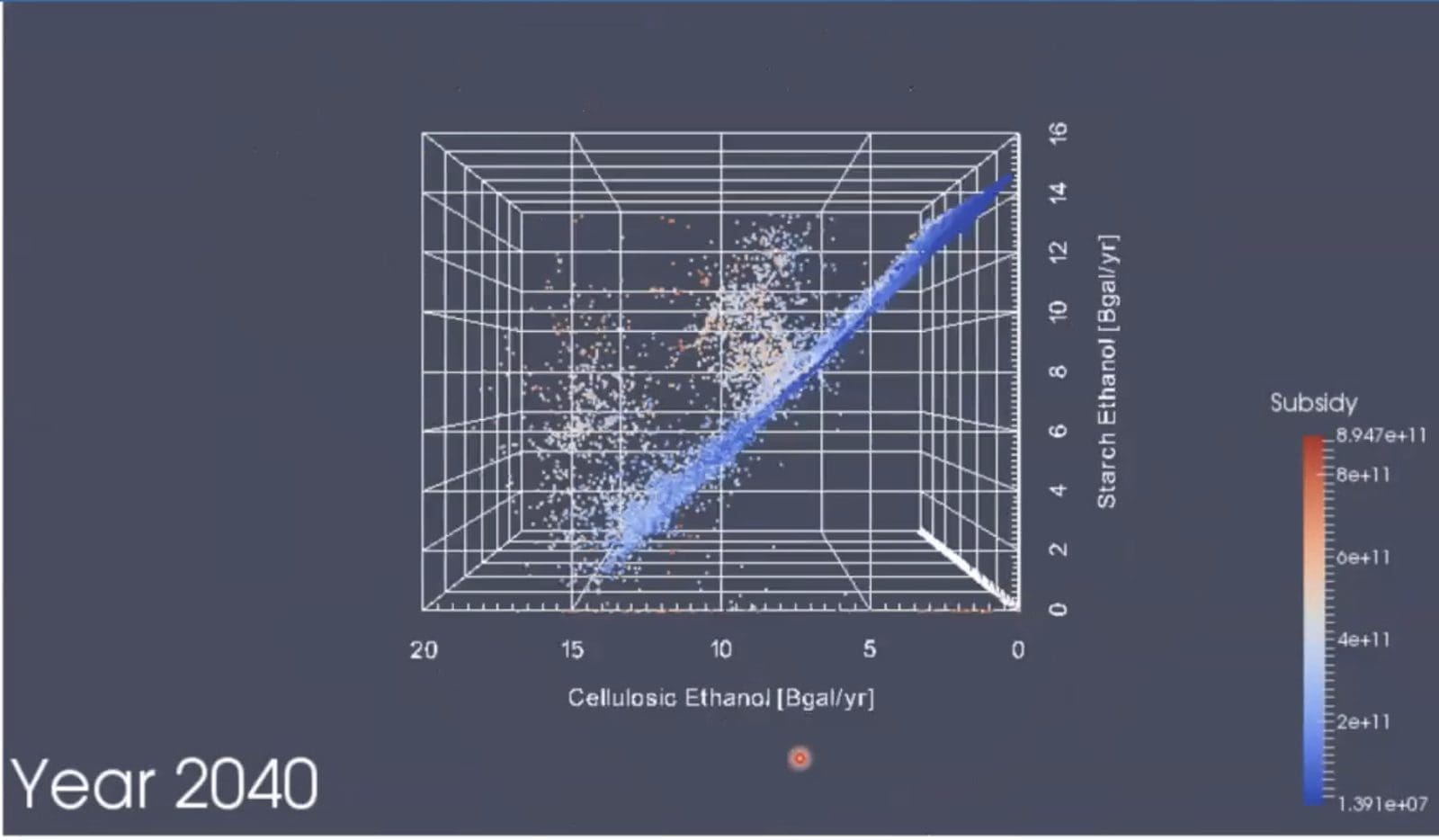
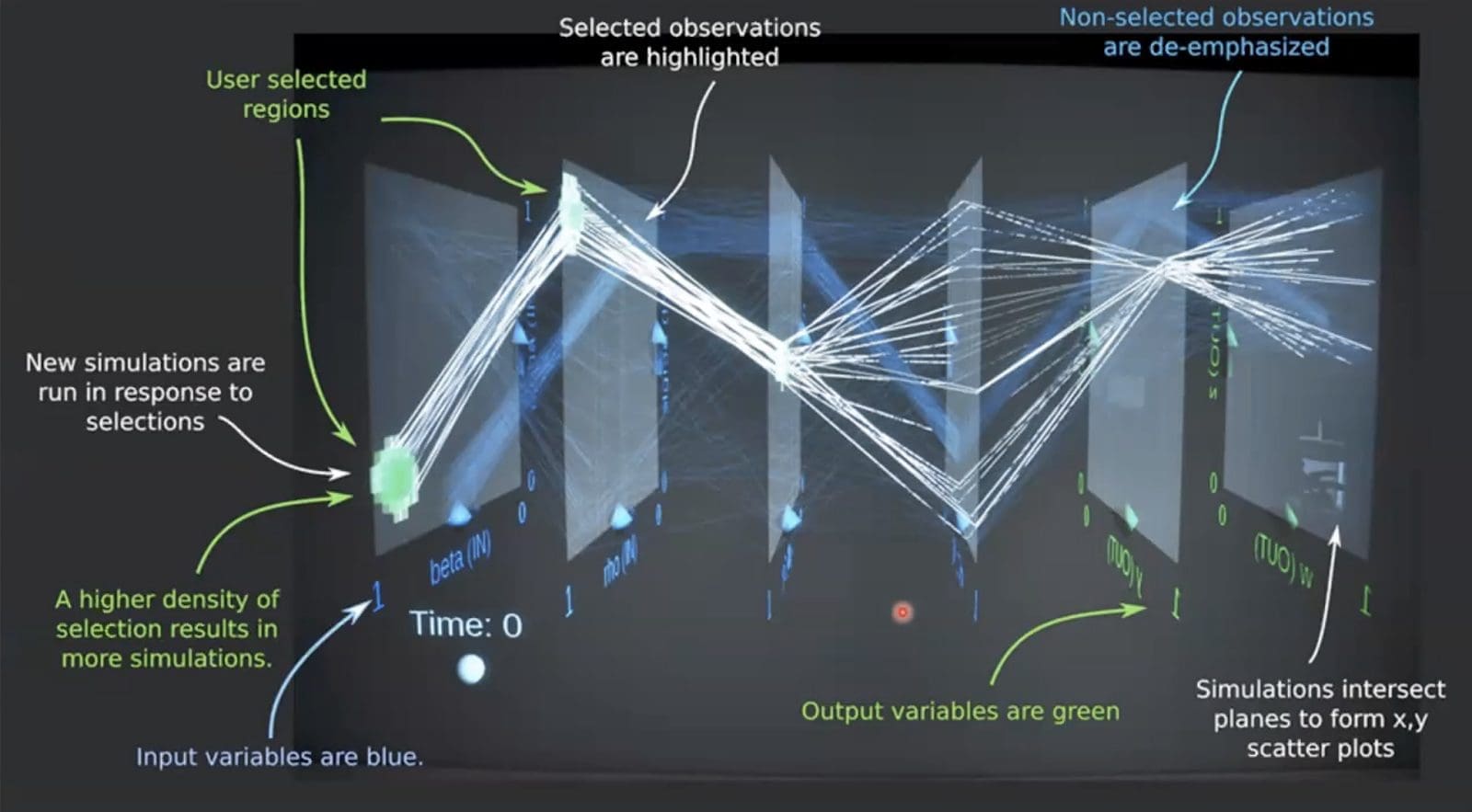
All in all, this was a pretty fantastic look at what the future of System Dynamics model outputs may look like. The immersive visual environments have a retro-futuristic feel, like a Star Trek holodeck brought to life. I doubt that this technology will ever trickle down to ordinary modelers in its full room-based form, though some of the visualization methods (e.g., 3-D scatterplots) are now available and getting some use. What does the future hold? That’s anybody’s guess, but I enjoyed seeing System Dynamics at the forefront of the discussion about how simulation modelers may someday be able to conveniently visualize and make sense of massive amounts of multi-dimensional data.
Billy Schoenberg – billy.schoenberg@iseesystems.com
Recent Posts
From Bergen to Global: UiB’s System Dynamics Group
From Bergen to Global: UiB’s System Dynamics Group The System Dynamics Group, an autonomous research group at the University of Bergen (UiB) was established in 1971 by professor emeritus Svein Nordbotten. Inspired by the work of Jay W. Forrester, Nordbotten...
Consideo’s Insight into the Global Energy Transition: A Systems Perspective
Consideo’s Insight into the Global Energy Transition: A Systems Perspective Complexities of Energy TransitionThe global energy transition is a complex challenge. The development of technology, the need for resources, the depletion of high-grade materials and...
A Digital Twin Business Model in 40 Hours
A Digital Twin Business Model in 40 Hours Though long past the date when I should have ‘retired’, I just can’t resist interesting projects, like the one a new friend brought me a few weeks ago. It concerns a small but fast-growing B2B business,...
Upcoming Events
MINDS Cast Ep. 5 – Expanding System Dynamics with Hybrid Modeling
This talk discusses extensions to System Dynamics modeling to integrate other modeling methods, notably Agent-Based Modeling. We will explore techniques for Agent-Based Modeling and how to integrate them into System Dynamics models; we will see how to extend...
Recent Business cases
Fast-Track Cities Uses System Dynamics to Enhance HIV Care
Fast-Track Cities Uses System Dynamics to Enhance HIV Care EXECUTIVE Summary Low levels of viral suppression at 69% for people with HIV make it hard to believe the 95% target level will be achieved by 2030 in St. Louis, USA. As a solution, Fast-Track Cities-STL opted...
System Dynamics Unravels ICU Tensions at the Portuguese Oncology Institute
System Dynamics Unravels ICU Tensions at the Portuguese Oncology Institute EXECUTIVE Summary The Portuguese Oncology Institute (IPO) faced a critical challenge in its intensive care unit (ICU) where doctors and nurses experienced high turnover due to tensions with...
System Dynamics Helps Farmers Escape Poverty Trap in Guatemala
System Dynamics Helps Farmers Escape Poverty Trap in Guatemala EXECUTIVE Summary Guatemala holds the 4th highest global ranking for chronic malnutrition, and climate change is intensifying the challenges subsistence farmers face in providing food for their families....

